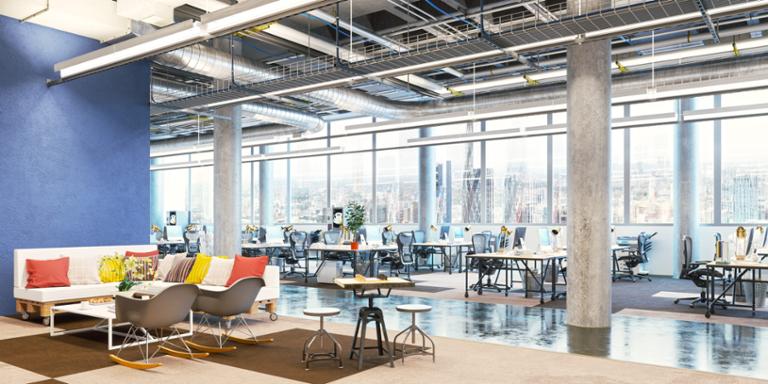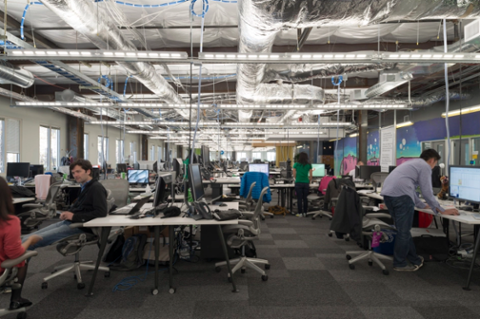 Open Office Floor Plan[/caption] Open offices are widely lamented by developers and others who like their own space, but large companies continue to hold such layouts up as bastions of good taste and productivity. For example, Apple’s infamous ‘spaceship’ headquarters in Cupertino features an open-office design. Why are we still doing this to ourselves? Perhaps the most glaring example of an open floor plan is Facebook’s new headquarters, reportedly the largest such design in the world. It’s 10 acres of desks under a shared roof, with even CEO Mark Zuckerberg working elbow-to-elbow with everyone else. It’s built to house over 2,800 engineers. Apple’s new campus was well thought-out, down to the door-handles that supposedly took over a year to design. The designers wanted the doorways to lack thresholds, because (according to a Reuters report) “if engineers had to adjust their gait while entering the building, they risked distraction from their work, according to a former construction manager.” But as The Wall Street Journal points out, some Apple employees are already taking issue with the design: “Coders and programmers are concerned that their work surroundings will be too noisy and distracting.” While not quite a Facebook-esque version of open workspace, the spaceship nonetheless seems to prioritize design over function. A common refrain in defense of open floor pans is cost, but neither Apple or Facebook can use that one (Apple’s new campus is rumored to have cost the company north of $5 billion). Google’s plan is so open that literally everything inside is modular; the campus becomes one with the community in Mountain View as well as the green-space around it.
Open Office Floor Plan[/caption] Open offices are widely lamented by developers and others who like their own space, but large companies continue to hold such layouts up as bastions of good taste and productivity. For example, Apple’s infamous ‘spaceship’ headquarters in Cupertino features an open-office design. Why are we still doing this to ourselves? Perhaps the most glaring example of an open floor plan is Facebook’s new headquarters, reportedly the largest such design in the world. It’s 10 acres of desks under a shared roof, with even CEO Mark Zuckerberg working elbow-to-elbow with everyone else. It’s built to house over 2,800 engineers. Apple’s new campus was well thought-out, down to the door-handles that supposedly took over a year to design. The designers wanted the doorways to lack thresholds, because (according to a Reuters report) “if engineers had to adjust their gait while entering the building, they risked distraction from their work, according to a former construction manager.” But as The Wall Street Journal points out, some Apple employees are already taking issue with the design: “Coders and programmers are concerned that their work surroundings will be too noisy and distracting.” While not quite a Facebook-esque version of open workspace, the spaceship nonetheless seems to prioritize design over function. A common refrain in defense of open floor pans is cost, but neither Apple or Facebook can use that one (Apple’s new campus is rumored to have cost the company north of $5 billion). Google’s plan is so open that literally everything inside is modular; the campus becomes one with the community in Mountain View as well as the green-space around it.
Is It Time for the Open Office Floor Plan to Die?
[caption id="attachment_142748" align="aligncenter" width="5000"]  Open Office Floor Plan[/caption] Open offices are widely lamented by developers and others who like their own space, but large companies continue to hold such layouts up as bastions of good taste and productivity. For example, Apple’s infamous ‘spaceship’ headquarters in Cupertino features an open-office design. Why are we still doing this to ourselves? Perhaps the most glaring example of an open floor plan is Facebook’s new headquarters, reportedly the largest such design in the world. It’s 10 acres of desks under a shared roof, with even CEO Mark Zuckerberg working elbow-to-elbow with everyone else. It’s built to house over 2,800 engineers. Apple’s new campus was well thought-out, down to the door-handles that supposedly took over a year to design. The designers wanted the doorways to lack thresholds, because (according to a Reuters report) “if engineers had to adjust their gait while entering the building, they risked distraction from their work, according to a former construction manager.” But as The Wall Street Journal points out, some Apple employees are already taking issue with the design: “Coders and programmers are concerned that their work surroundings will be too noisy and distracting.” While not quite a Facebook-esque version of open workspace, the spaceship nonetheless seems to prioritize design over function. A common refrain in defense of open floor pans is cost, but neither Apple or Facebook can use that one (Apple’s new campus is rumored to have cost the company north of $5 billion). Google’s plan is so open that literally everything inside is modular; the campus becomes one with the community in Mountain View as well as the green-space around it.
Open Office Floor Plan[/caption] Open offices are widely lamented by developers and others who like their own space, but large companies continue to hold such layouts up as bastions of good taste and productivity. For example, Apple’s infamous ‘spaceship’ headquarters in Cupertino features an open-office design. Why are we still doing this to ourselves? Perhaps the most glaring example of an open floor plan is Facebook’s new headquarters, reportedly the largest such design in the world. It’s 10 acres of desks under a shared roof, with even CEO Mark Zuckerberg working elbow-to-elbow with everyone else. It’s built to house over 2,800 engineers. Apple’s new campus was well thought-out, down to the door-handles that supposedly took over a year to design. The designers wanted the doorways to lack thresholds, because (according to a Reuters report) “if engineers had to adjust their gait while entering the building, they risked distraction from their work, according to a former construction manager.” But as The Wall Street Journal points out, some Apple employees are already taking issue with the design: “Coders and programmers are concerned that their work surroundings will be too noisy and distracting.” While not quite a Facebook-esque version of open workspace, the spaceship nonetheless seems to prioritize design over function. A common refrain in defense of open floor pans is cost, but neither Apple or Facebook can use that one (Apple’s new campus is rumored to have cost the company north of $5 billion). Google’s plan is so open that literally everything inside is modular; the campus becomes one with the community in Mountain View as well as the green-space around it.
 Open Office Floor Plan[/caption] Open offices are widely lamented by developers and others who like their own space, but large companies continue to hold such layouts up as bastions of good taste and productivity. For example, Apple’s infamous ‘spaceship’ headquarters in Cupertino features an open-office design. Why are we still doing this to ourselves? Perhaps the most glaring example of an open floor plan is Facebook’s new headquarters, reportedly the largest such design in the world. It’s 10 acres of desks under a shared roof, with even CEO Mark Zuckerberg working elbow-to-elbow with everyone else. It’s built to house over 2,800 engineers. Apple’s new campus was well thought-out, down to the door-handles that supposedly took over a year to design. The designers wanted the doorways to lack thresholds, because (according to a Reuters report) “if engineers had to adjust their gait while entering the building, they risked distraction from their work, according to a former construction manager.” But as The Wall Street Journal points out, some Apple employees are already taking issue with the design: “Coders and programmers are concerned that their work surroundings will be too noisy and distracting.” While not quite a Facebook-esque version of open workspace, the spaceship nonetheless seems to prioritize design over function. A common refrain in defense of open floor pans is cost, but neither Apple or Facebook can use that one (Apple’s new campus is rumored to have cost the company north of $5 billion). Google’s plan is so open that literally everything inside is modular; the campus becomes one with the community in Mountain View as well as the green-space around it.
Open Office Floor Plan[/caption] Open offices are widely lamented by developers and others who like their own space, but large companies continue to hold such layouts up as bastions of good taste and productivity. For example, Apple’s infamous ‘spaceship’ headquarters in Cupertino features an open-office design. Why are we still doing this to ourselves? Perhaps the most glaring example of an open floor plan is Facebook’s new headquarters, reportedly the largest such design in the world. It’s 10 acres of desks under a shared roof, with even CEO Mark Zuckerberg working elbow-to-elbow with everyone else. It’s built to house over 2,800 engineers. Apple’s new campus was well thought-out, down to the door-handles that supposedly took over a year to design. The designers wanted the doorways to lack thresholds, because (according to a Reuters report) “if engineers had to adjust their gait while entering the building, they risked distraction from their work, according to a former construction manager.” But as The Wall Street Journal points out, some Apple employees are already taking issue with the design: “Coders and programmers are concerned that their work surroundings will be too noisy and distracting.” While not quite a Facebook-esque version of open workspace, the spaceship nonetheless seems to prioritize design over function. A common refrain in defense of open floor pans is cost, but neither Apple or Facebook can use that one (Apple’s new campus is rumored to have cost the company north of $5 billion). Google’s plan is so open that literally everything inside is modular; the campus becomes one with the community in Mountain View as well as the green-space around it.


